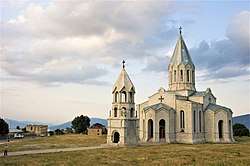Saint Catherine's Armenian Church
St. Catherine's Armenian Church (Russian: Армянская церковь Святой Екатерины, Armyanskaya tserkov Svyatoy Yekaterini; Armenian: Սուրբ Կատարինե եկեղեցի, Surb Katarine yekeghetsi) is an Armenian Apostolic church on Nevsky Prospect, in central Saint Petersburg, Russia. Built in the 1770s, it is one of the earliest Armenian churches in Russia.
| Saint Catherine's Armenian Church | |
|---|---|
.jpg) | |
| Religion | |
| Affiliation | Armenian Apostolic Church |
| Year consecrated | February 18, 1780[1] |
| Status | Active |
| Location | |
| Location | 40-42 Nevsky Prospect, Saint Petersburg, Russia[2][3][1] |
| Geographic coordinates | 59.93526°N 30.33318°E |
| Architecture | |
| Architect(s) | Yury Felten |
| Style | Neoclassical, Russian Classicism |
| Groundbreaking | 1771[1] |
| Completed | 1776[1] |
History

Foundation
Private stables of Empress Elizabeth of Russia stood on its location in the mid-18th century,[2] until it was granted to Petersburg Armenians on May 2, 1770 by Empress Catherine the Great, upon the request of her Armenian jeweler Ivan Lazarev.[4] Its construction was primarily financed by Lazarev,[2][5] who provided 30,000 rubles of the total 33,000.[6] The church was designed by Yury Felten[4][2] and is an early example of Russian Classicism.[2] Its construction began in the spring of 1771[1] and was completed in 1776.[7] The church was consecrated on February 18, 1780 by Hovsep Arghutian (Prince Argutinsky-Dolgorukov), the archbishop of the Russian diocese of the Armenian church, in attendance of Prince Grigory Potemkin, the favourite of Catherine the Great.[4][3] It is named after Catherine of Alexandria, a namesake of the empress.[8] Colored white and blue, it has a neoclassical portico and single cupola.[9]
Later history
It became the center of Armenian cultural activity in the Russian imperial capital.[10][11] The first Armenian publishing house in Russia functioned nearby.[12] The church did not have bells until 1865, when Khristofo E. Lazarev received permission to install them. The church was completely renovated by the Russian-Armenian architect Alexander Tamanian in 1906–09.[4][1]
The church was closed down by Soviet authorities no later than May 1930.[7] During the Second World War, the building served as the headquarters of the anti-aircraft defense and later as a decoration room of the Leningrad Theater of Musical Comedy.[3][7][13] The Armenian community regained ownership of the church in August 1992[7][4] and the first mass took place in March 1993.[7] After thorough restoration, the church was reconsecrated on July 12, 2000 by Karekin II, Catholicos of All Armenians, and Patriarch Alexy II of Moscow.[3] It was renovated again in 2014.[14]
Gallery
References
- Gadlo & Bessonov 2002, p. 231.
- FitzLyon, Kyril; Zinovieff, Kyril; Hughes, Jenny (2003). The Companion Guide to St Petersburg. Companion Guides. p. 185. ISBN 9781900639408.
- "Экскурсия в армянскую церковь святой Екатерины [Tour through the Armenian Church of Saint Catherine]". spbda.ru. Saint Petersburg Theological Academy (Russian Orthodox Church). 3 February 2011. Archived from the original on 9 June 2017.
- "Церковь Святой Екатерины в Санкт-Петербурге [Saint Catherine's Church in Saint Petersburg]". armenian-church.org (in Russian). New Nakhichevan and Russia Diocese of the Armenian Apostolic Church. Archived from the original on 11 June 2017.
- Suny, Ronald Grigor (1993). Looking Toward Ararat: Armenia in Modern History. Indiana University Press. p. 35. ISBN 9780253207739.
- "St. Catherine's Armenian Church". Yerevan Magazine. Archived from the original on 10 June 2017.
- Gadlo & Bessonov 2002, p. 232.
- Oreshkin, Daria. "Мультикультурная столица: самые красивые и необычные храмы Санкт-Петербурга". Sputnik.ru (in Russian).
- St. Petersburg. Dorling Kindersley. 2007. p. 108.
- Khachatryan, Vardan; Ananyan, Zhores; Sargsyan, Aram; Khudaverdyan, Kosntandin (2003). "Ռուսաստան [Russia]". In Ayvazyan, Hovhannes (ed.). Հայ Սփյուռք հանրագիտարան [Encyclopedia of Armenian Diaspora] (in Armenian). 1. Yerevan: Armenian Encyclopedia. p. 485. ISBN 5-89700-020-4.
- Mirzoyan, Tigran (22 May 2017). "Армянские жемчужины Крыма и Санкт-Петербурга [Armenian pearls of Crimea and Saint Petersburg]". Golos Armenii (in Russian).
- "Об общине [About the community]". spb.mfa.am. Consulate general of Armenia in Saint Petersburg. Archived from the original on 9 June 2017.
- Antonov, V. V.; Kobak, Aleksandr B. (2003). Святыни Санкт-Петербурга: христианская историко-церковная энциклопедия [Holy Places of Saint Petersburg: Christian Historical-Ecclesiastical Encyclopedia] (in Russian). Liki Rossii. p. 380.
В здании находился штаб ПВО, а после войны - мастерская декораций театра музыкальной комедии.
- Karapetyan, Viktoria (2 July 2014). "Սանկտ-Պետերբուրգի սուրբ Կատարինե հայկական եկեղեցին [Saint Catherine's Armenian Church of Saint Petersburg]" (article). Shoghakat TV.
- Books
- Gadlo, Aleksandr Vilʹi͡amovich; Bessonov, Nikolaĭ Vladislavovich (2002). Многонациональный Петербург: история, религии, народы [Multiethnic Petersburg: history, religion, peoples] (in Russian). Iskusstvo–SPB. ISBN 9785210015495.CS1 maint: ref=harv (link)
.jpg)
